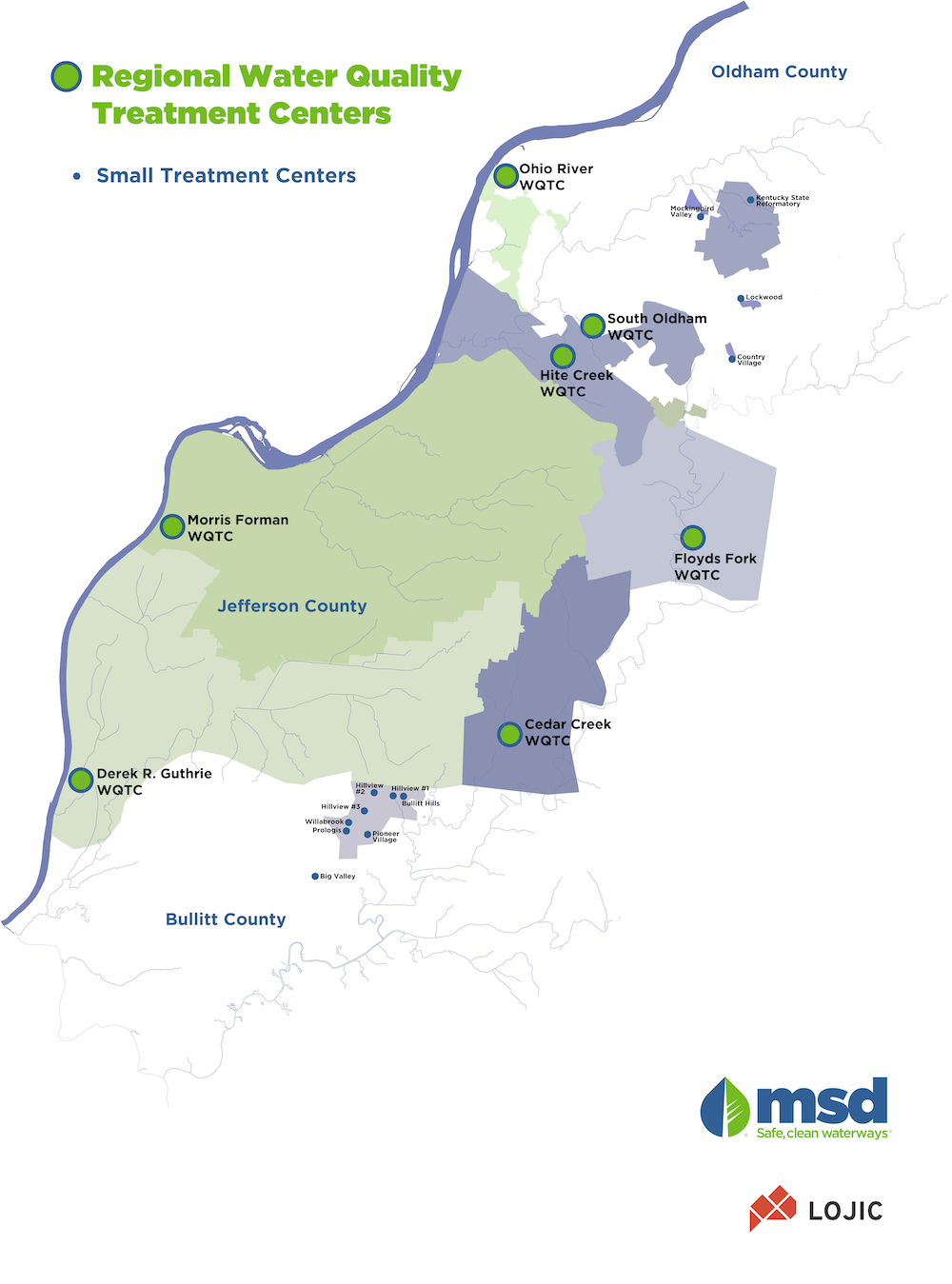Waste·water n: Water that has been used for domestic or industrial purposes.
Waste·water treat·ment n: Physical, chemical and biological processes used to remove pollutants from wastewater before discharging it into a water body.
See how MSD helps track disease in the community
The basics of wastewater treatment
How do we take wastewater, clean it and put that water back into a local waterway cleaner than the water already in that stream or river?
First Step—Take out the trash
To treat the wastewater, we must first remove the trash that has made its way into the sewer system, such as plastic items, wipes, dental floss, hair or small toys.
Toilets are not trash cans. Please do not flush anything except human waste and toilet paper.

Second Step—Put the micro-organisms to work
Solids and liquids separate in tanks. While liquids remain on top, the solids settle to the bottom, where micro-organisms help them decompose. The water goes to the filtration process and while the decomposed waste is processed as a soil amendment or disposed of at a landfill.
Third Step—Filter the water
The water passes through fine filters removing any remaining inorganic compounds, suspended solids, and trace amounts of nitrogen and phosphorus.
Last Step—Zap the microorganisms
Wastewater is disinfected by either UV light or chemical processes and released into the receiving waterbody cleaner than the water already there. The environmental standards for each watershed are unique and MSD strives to meet or exceed all water quality regulations.

Water Quality Treatment Centers
Protecting waterways throughout our service area—which includes portions of the Kentucky counties of Bullitt, Jefferson and Oldham—is our mission by collecting and treating wastewater before it is released back into our local waterways.
Our region is home to seven regional Water Quality Treatment Centers (WQTCs). Each is unique and helps provide our community with safe, clean waterways and a healthy environment.
Additionally, we service some Bullitt and Oldham counties areas through small package treatment centers. These serve areas outside of the regional sewer collection and treatment system.
Bullitt County
Improved wastewater treatment and expanded service capacity are in store for Bullitt County following Louisville MSD’s acquisition of the Bullitt County Sanitation District, Hunter’s Hollow Treatment Plant and Big Valley Sewer Utility on November 30, 2021.
MSD operates and maintains Bullitt County’s smaller treatment plants for full compliance with all regulatory agencies. Planning is underway to decommission some smaller treatment plants that have passed their useful life and manage that service through the Derek R. Guthrie Water Quality Treatment Center in Jefferson County.
Jefferson County
Every day, MSD cleans nearly 154 million gallons of wastewater in Jefferson County at five regional Water Quality Treatment Centers and then releases it into our local waterways.
In 2016, MSD completed a 36-year transition to regional wastewater treatment by closing more than 300 small package treatment centers in Jefferson County.
Cedar Creek WQTC
Daily, the Cedar Creek WQTC receives an average of 6 million gallons of wastewater. At this WQTC, wastewater goes through all steps of the treatment process, including UV disinfection, before being released into Cedar Creek.
Derek R. Guthrie WQTC
This facility treats an average of 40 million gallons of wastewater per day. Wastewater goes through all treatment steps, including sodium hypochlorite disinfection, before being released into the Ohio River.
Floyds Fork WQTC
This facility receives an average of 3.5 million gallons of wastewater per day. Here, wastewater goes through all steps of the treatment process, including UV disinfection, before being released into Floyds Fork.
Hite Creek WQTC
An average of 4.4 million gallons of wastewater per day goes through all steps of the treatment process, including UV disinfection, before being released into Hite Creek.
Morris Forman WQTC
Beginning service in 1958, Morris Forman WQTC is Kentucky’s largest and oldest water quality treatment facility. On a typical day, it treats 100 million gallons of wastewater and up to 350 million gallons per day during storms. Wastewater goes through all steps of the treatment process, including chlorination and dechlorination, before being released into the Ohio River. Morris Forman WQTC also handles biosolid processing for all five WQTCs in Louisville Metro.
Oldham County
In Oldham County, we clean about 2.0 million gallons of wastewater each day at two regional Water Quality Treatment Centers and five small package treatment centers releasing it into the local waterways cleaner than the water that is already in the waterway. Louisville MSD purchased the Oldham County Environmental Authority wastewater system in 2019.
Storage Basins
Underground storage basins are important tools in the elimination of sewer overflows. When heavy rains create more flow than the MSD Water Quality Treatment Center system can handle at one time, the overflowing sewage and stormwater gets directed into basins for temporary storage. As the rain slows down, and the treatment system catches up, the stored flow is pumped back into the system to be treated before being released into area waterways. Learn more about Storage Basins.
Jefferson County, Kentucky
Jefferson County contains 790 miles of streams, 130 miles of improved channels and 38 miles of Ohio River shoreline—all of which are part of the following watersheds:
· Beargrass Creek-Middle Fork
· Beargrass Creek-Muddy Fork
· Beargrass Creek-South Fork
· Cedar Creek
· Floyds Fork
· Goose Creek
· Harrods Creek
· Mill Creek
· Ohio River
· Pennsylvania Run
· Pond Creek
Helpful tips
“Flushable wipes” do not break down properly in the sewer system. As a result, these wipes clog sewer pipes, potentially leading to sewer backups. In addition, they clog and damage sewer line pumps, screens and other mechanical parts at local wastewater treatment centers.
Unclogging and making repairs to pumps cost MSD ratepayers approximately $90,000 a year. Wet wipes cause the majority of the clogs.
Click here to learn more about how you can help.
Send a Floyds Fork Water Quality Treatment Center card to a friend and let them know about safe, clean waterways!



